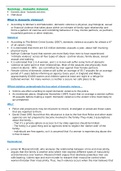Sociology – Domestic violence!
Domestic abuse - husbands and wives
Child abuse!
What is domestic violence?
According to Women’s Aid Federation, domestic violence is physical, psychological, sexual
or financial violence that takes place within an intimate of family-type relationship and
forms a pattern of coercive and controlling behaviour. It may involve partners, ex partners,
household partners or other relatives.
Statistics!
According to The British Crime Survey (2007), domestic violence accounts for almost a 6 th
of all violent crime.
It is estimated that there are 6.6 million domestic assaults a year, about half involving
physical injury.
Kathryn Coleman found that women are more likely than men to have experienced
‘intimate violence’ across all four types of abuse – partner abuse, family abuse, sexual
assault and stalking.
It is estimated that 1 in 4 women, and 1 in 6 men will suffer some form of domestic
violence at some point in their relationships. Most of the assaults and physically most
violent incidents - 89% - are committed by men against their female partners.
Female victims of domestic violence will suffer an average of 35-7 assaults for an average
period of 7 years before informing an agency. Every year, in England and Wales,
approximately 63,000 women and children spend at least one night in a refuge for
battered women. For many women, is neither a secure nor safe place to be.
Official statistics underestimate the true extent of domestic violence…
Victims are often unwilling to report domestic violence to the police.
As mentioned above, Stephaine Yearnshire (1997) found that on average a women suffers
35 assaults before making a report. Domestic violence is the violent crime most likely to
go unreported.
Why?
Police and prosecutors may be reluctant to record, investigate or prosecute those cases
that are reported to them.
David Cheal 1991 found that this reluctance is due to the fact that Police and other state
agencies are not prepared to become involved in the family. They make 3 assumptions
about the family…
- That it’s a private sphere so access to it by state agencies should be limited.
- The family is a good thing and so agencies tend to neglect the ‘darker side’ of the
family.
- Individuals are free agents, so it is assumed that if a woman is experiencing abuse she
is free to leave.
Explanations!
James W. Messerschmidt, who analyses the relationship between crime and masculinity,
argues that the family is another area where men express different types of masculinity
and dominance over women. Messerschmidt argues that relatively powerless men use
wife-beating, violent rape and even murder to reassert their masculine control when
women threaten their masculinity. Thus, much violence occurs when the man believes that





